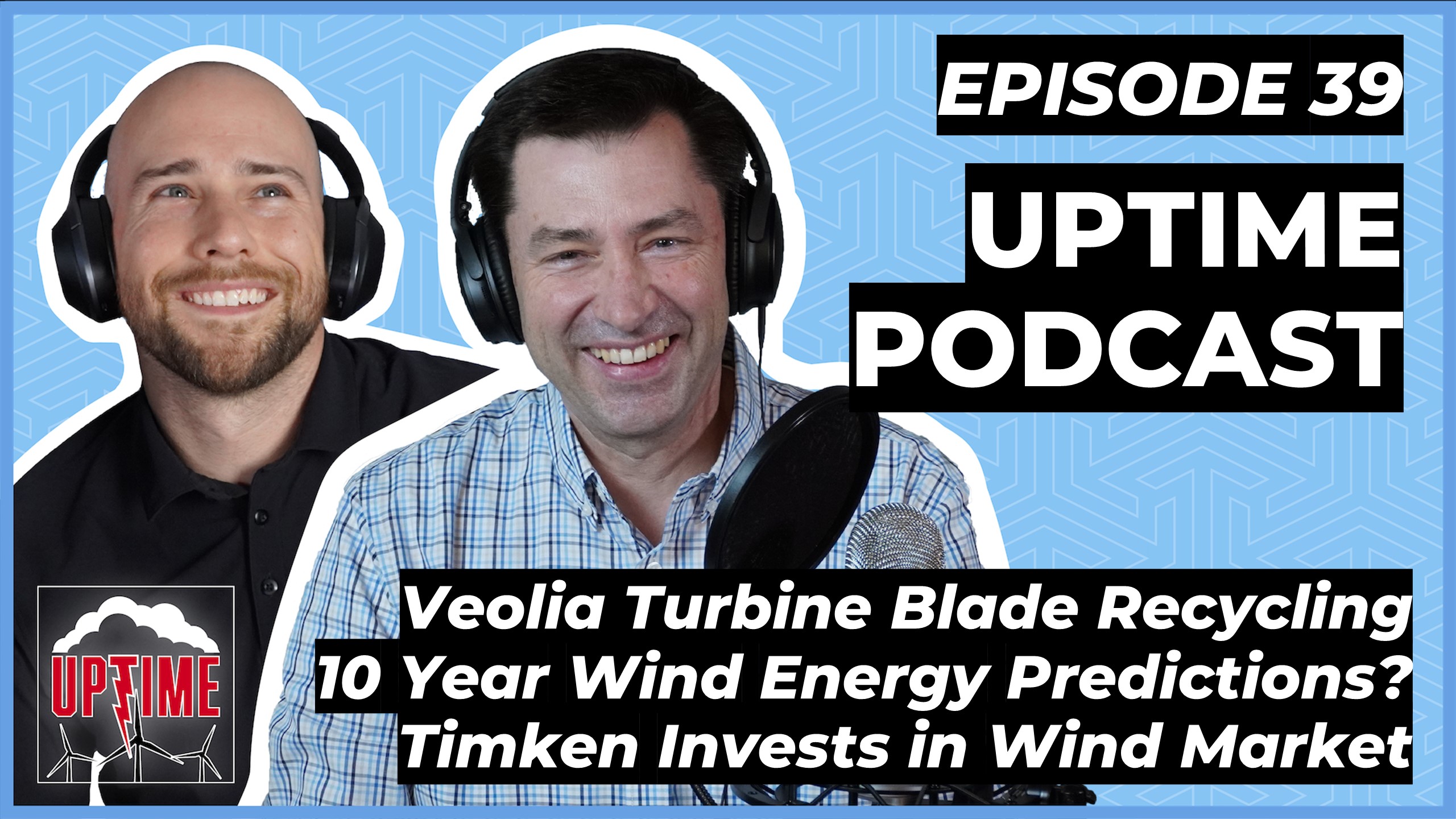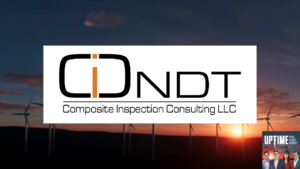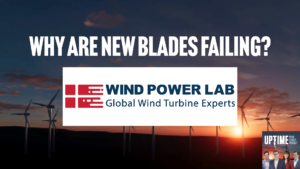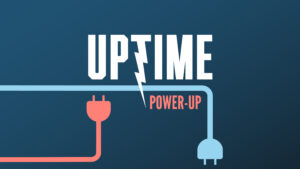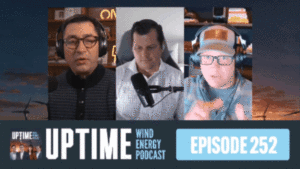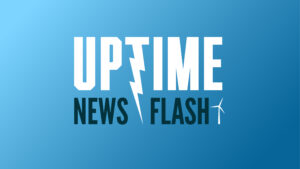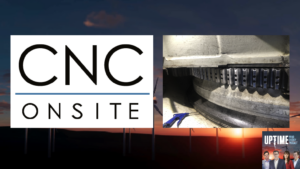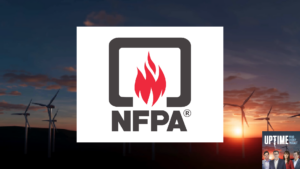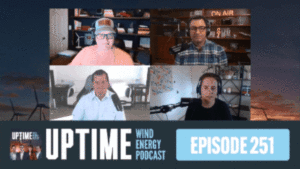Veolia has partnered with GE on wind turbine blade recycling, which hopefully means big things for the environment. Amazon committed to buy 250MW of renewable wind power from Orsted, Wood Mackenzie predicts market share 10 years from now on the big three turbine manufacturers – are predictions like this even…useful? And, Timken is investing $75MM in the wind energy market – is this a big deal and a boon for the reliability of turbine bearings?
Learn more about Weather Guard Lightning Tech’s StrikeTape Wind Turbine LPS retrofit. Follow the show on YouTube, Twitter, Linkedin and visit Weather Guard on the web. Have a question we can answer on the show? Email us!
Podcast: Play in new window | Download
Transcript EP39 – Veolia Wind Turbine Blade Recycling, Timken, Amazon and 10-Year Predictions
welcome back i’m Allen Hall i’m Dan Blewett and this is the uptime podcast where we talk about wind energy engineering lightning protection and ways to keep your wind turbines running all right welcome back to the uptime podcast i’m your co-host Dan Blewett and on today’s show we’ve got a bunch of great topics number one uh GE choosing Veolia wind turbine blade recycling – it’s actually a really interesting story about the way they intend to use that in cement mix an interesting article uh by the consulting firm would mackenzie predicting siemens gonna go mesa renewable energy vestas and ge and how they’ll increase their market share over the next decade uh interesting article about amazon committing to buy uh 250 megawatts of power from orsted in europe and then our tech segment we’ll talk a little bit about timken and their uh commitment to invest 75 million to increase their uh capacity and wind energy and lastly we’ll talk a little bit about green ammonia and vestus backing a wind plant to do that so al let’s start with uh ge and veolia so obviously we’ve talked before about wind turbine blade recycling being a big problem because these things are enormous and there’s no good way to put a good place to put them and they don’t really just like mold well into the environment i mean we’re just burying them at the moment and trying to find places to put them so uh tell us about this article about violia and their agreement of how to process these so ge has been working for the last couple of years on how to recycle the blades because some of those blades are starting to come out of service and they’ve they’ve been looking at recycling for a while but obviously it’s you know where do you recycle it where is it going to go where are you going to put it back into the ecosystem and it it looks like they found a home in the cement industry and the article is interesting uh because it was addressing sort of two different pieces to the cement uh when you manufacture cement it kind of goes to a killing process so they’re using the the first of all they grind up the blades which is a it’s a massive problem because when anything that’s made out of epoxy and fiberglass is inherently tough and to grind that into usable chunks or pieces is not easy so it’s like putting it through a gigantic paper shredder but on the on the world’s most largest paper shredder industrial scale paper shredder it’s got to sit there and just kind of chew at it uh if you ever try to cut yeah you ever try to cut uh fiberglass uh with like a a grinder or something it’s just it gets hot and it melts and it gets gooey so you can’t there’s only certain ways to attack that problem so grinding it up first the big problem but once you get it ground up now you have all this fiberglass which is a great additive to any sort of cement mix because it actually prevents the cement from cracking and coming apart because you got this these fiber binders that hold it together so you have this engineered cement system which is really useful but the second part was they must be burning off the epoxy and epoxy does burn so in that kiln process it sounds like they’re reducing the amount of coal used to heat these kilns up by burning the fiber the epoxy off is what it sounds like so i kind of went about that part of it a little bit obvious obviously ge is full of really bright engineers they’ve been that way for a hundred years uh so i’m sure they looked at what the emissions out of that are and what the trade-off is maybe just going through some scrubbers but that is fascinating because it was it wasn’t a few episodes ago maybe 20 episodes ago we were talking about how they were burying blades in iowa basically just digging a hole and dropping them in and putting dirt over them and now yeah now a couple months later we’re recycling them uh some maybe the the pr from that burial had something to do with you know really kicking this into high drive don’t you think that had something to do with the pr part of this recycling bit yeah maybe and of course well you’ve probably seen these shredding videos on youtube too and there’s i mean whole channels i think where people are just tossing different items into these industrial shredders i mean they have these just shred hole cars right they shred engine blocks they i mean so it seems like those are definitely up to the task but like you said this is a really long i mean you’re feeding potentially 100 meters into one of these right you know almost like wood chipper devices and they can definitely handle it but you said like you said it’s a slow process it it’s got to be i’m sure like the right kind of teeth as they grind it up yeah i mean that seems like it makes sense but like you said there’s probably a lot of and that’s really interesting it says up to 28 the blade weight would actually provide energy for the chemical reaction that would happen in the kiln so it does sound like a pretty good fit which yeah that seems like probably one of the best solutions that we’ve heard of thus far right and we haven’t really heard much in europe on blade recycling it seems like what we have heard has been in the united states mostly probably because there’s a lot of wind turbines in the united states they’re coming of age so they need to do something with them but i haven’t heard so much in europe and definitely haven’t heard anything in china about it so it is good right if you can recycle it and use it for an another highly complex energy-intensive process fantastic so sort of hats off to ge here
so moving on wood mackenzie the consulting firm i know they’re they own green greentechmedia.com um they put out an article that says the top three turbine oems are poised to you know really boost their market share between now and 2029 so potentially going from 43 in 2019 to 60 a decade later in 2029 and that includes vestus siemens gamesa renewable energy and ge so how do you feel about this i mean that’s a lot of conjecture obviously they have some of the world’s brightest consultants but that’s a long period of time to to really speculate on you know market share and and growth and all that for businesses i i think so too especially if you’re going to invest and dan you do investing so you have a sense of it would you invest in something like that that had a predictive uh return ten years out i don’t think that i would it’s just too much risk i mean i just it just i just don’t know that we know what the world looks like in 2020 in 2025 right i mean the world’s very different today than it was in 2015 right so yeah uh i mean it seems like obviously these projects have a longer trend right like we could talk about some of these new wind projects being built and they’re not even going to be in you know complete for five you know four three four five six seven years in some cases so i guess you can predict out pretty far as far as like you know contracts and and what they’re proposing to do but just 10 years from now i just i i wouldn’t personally have any take any stock and what’s going to happen 10 years from now i i wouldn’t either honestly it just it wouldn’t make any sense just because if you think about the leadership of any corporation and all it takes is one significant event uh earthquake fire
one of those and all that goes to zero all the predictions go to zero well also just like Paul Gipe was talking about you know like there’s a lot of technologies that are going to get a lot cheaper in the next five years i mean he talks about it’s a lot easier to put solar you know if you’re a homeowner rather than put a small wind turbine out it’s way easier and way cheaper to put out solar panels so it’s hard to really say in five even in five years not even 10 years from now you know where battery technology leads us where you know all these different things i mean tesla’s done so much for pushing technology you know as far as electric storage and all that i it’s just hard to know where we’re going this way what if we were able to develop fusion power in 2025 do we have wind not at the scale we do now we won’t uh you know that’s a huge game changer but we in in the in all of the 20th century think about all the game changing things that happened from flying to uh having uh what running water in homes and sanitation and automobiles and all and television and radio and all those different things and that uh no one would have would have predicted why would that be any different in this century right i don’t think that it will be so it’s so hard to predict i always when i always hear a 10-year plan i always think back to the soviets five-year plans which never were predictive of anything and then i think well if the soviets couldn’t do five so we ought to stick to maybe two or three maybe two or three years out we could quasi-predict and that’s about the limit of prediction i think yeah and i would tend to agree and we’ve talked a bunch of about recently about just different books we’ve read and like i said for me reading a bunch of uh nassim nicholas talleb’s work and he’s constantly talking about predictions and randomness and you know the stock market and how people just need to be aware that much more of it is a random than they think even when they’re making seemingly good decisions like hey we thought this was going to happen and it did he’s like um that was a lot more random than you than you thought it was and that humans are just really not good at predicting they’re just really not exactly so what value do these predictive articles have don’t you always wanted that like you see we’re in 2050 to be gonna be flying in spaceships you’re like uh you know whatever okay so you just kind of just out of hand discount it but 2029 is like okay it’s close enough that i could i can see it but who’s acting on that right because investors like you as sort of the individual level are not reacting to it is it is it just a pr play or is it trying to push marketplaces in different you know then which wall street tests all the time yeah well what’s the point what’s the point about an article like that it’s like saying uh you’re gonna know what apple’s producing three years from now you have no idea i i don’t have any idea i’m probably closer to it than some people and i have no idea so what’s up what’s the point of the art yeah it’s like it’s a good question and i’m certainly not deep into the the consulting world and um i think analysts are just paid to analyze it seems like in a lot of and just try to make the most i don’t know just try to speculate on what the world’s going to look like but i think that that really is more of what it is it’s speculation rather than yeah right i think it’s speculation and from the engineer’s standpoint having watched the analysts come into to a couple of different companies that i’ve worked for or participate in their ability to predict the future has not been very good and when the companies have taken the direction of the analysts it’s never really worked out now let’s say that it doesn’t in general work out but it hasn’t worked out in the technology companies i’ve been involved with and i always think who knows more about the characteristics of the companies in the company themselves if you want to know what’s going to happen inside of picket siemens gamesa two years from now it’s not very hard to find out i mean knock on the couple the engineers doors over there and know that they have a pretty good idea where the company is going in two years for sure way more than an analyst for me right yeah well in apple recently i mean we’ve we’ve talked about um you know their new computer tech apple just released their new macbooks with m1 chip well they’ve been developing that that didn’t happen in the last nine months they’ve been developing that chip in secret for what five years probably slowly 15. putting all the processes together but it’s just now to most of the public hey they’ve got new chips like hey there i mean i think the story broke that they were developing it that this was coming maybe nine months ago a year ago so and of course you just i mean if that’s the when the public learns you know there’s a lot of people who are a lot deeper than that who are aware that that was coming but then there’s still but no one that’s been going on for a long a long time and people just didn’t well isn’t that interesting because i do think you bring up that you bring the right point which is that obviously all the engineers working at apple and the and the products they were developing had that technology in it for quite a while right and but i didn’t read any articles talking about the future uh computational ability of basically simplified processors in any article in anything in the last five years but in the last month there’s been a whole plethora of them where were you a year ago right so if you’re analyzing the if you’re analyzing the industry how do you miss that one and how does that not get out into the get to the general public’s knowledge like hey apple is going to kill it in in a year by apple you didn’t hear that maybe maybe i missed it i don’t think so i’m pretty tight into apple i didn’t hear it either right so and now as yeah this is kind of the same thing where intel has been what a massive player in chip production right for the longest time and now so if you were to forecast five years ago that intel who’s already dominant is going to continue just to like increase their market share which i mean maybe you’d say that maybe wouldn’t but just as a hypothetical um would you have foreseen that apple was going to come and basically hurt them big time nope like yeah it’s a huge i mean intel’s going to be really hurt by this oh so yeah it’s like predicting that someday you would not have an ibm computer on your desktop because there was a while there and you thought this is going to happen forever or always thinking that microsoft is going to be the the greatest company in the world and it just isn’t you know things come and go and it’s so hard it’s just to predict that i think it’s like going to vegas you might as well go to vegas because at least the odds are somewhat controlled there right you kind of know what you’re walking into you don’t know what you’re walking into to any business because it’s and the way to think about a business from the engineering standpoint is it’s a living breathing organism that’s essentially what it is and there’s a lot of ways those organisms to go wrong and history has shown us that once big companies get going in a certain direction it is really really hard for them to make any sort of adjustments going forward so if there is new technology or a smaller company that’s more adaptive the big companies are in trouble go to kmart go to sears go to jcpenney right when i was a kid they were the they were the places where you would shop and they just control the whole marketplace not around anymore and that’s 20 years ago right so it doesn’t take long for the world to change substantially and and i always that’s why i think all these articles yeah take with a grain of salt well and one more thing about you know not this isn’t forecasting this is a real thing but uh amazon has signed a deal with orsted to buy 250 megawatts from their 900 megawatt uh borkum riftground 3 wind farm and that’s going to help our amazon get get to its target of being 100 renewable by 2030 and net zero by 2040. so obviously wind power is here to stay right no one’s debating that it’s going to be a percentage even if we got fusion power right wind power is still going to be a large chunk like no there’s a lot of um what’s the word here um diversity in sure just where all of our power comes always has been so amazon’s committed to buying a large chunk of in the future with a ppa with them um do you feel like this is gonna get other companies to follow suit i mean amazon’s the big bad wolf in some regards here in the u.s and of course it’s beloved by a lot of consumers as well but i mean is apple are these other big companies going to be doing the same thing following us i think they’re going to try anytime you can lock in one of your key constraints to growth which is power consumption if you can lock it lock in long-term agreements on what how much the cost of power is you you really want to do that you see the same thing in the airline industry when they can buy long-term contracts on fuel pricing where they know what that is even if it’s slightly higher than what they really are willing to pay at least they know what it is so from an amazon standpoint this is a two-part play one is a pr relations thing where they’re they’re trying to show themselves to be very green and eco-friendly and all that but you gotta think about how they operate their business right their business is trucks and airplanes and and uh delivery vehicles and it’s going to be drones pretty soon right so they have a lot of vehicles on the road and now they own or operate a lot of aircraft they’re starting their own airline fleet that’s essentially what they’re doing uh because they that break with fedex so there’s just a lot of gyrations so part of it is somewhat diversionary like hey we want to be green but the same time we’re delivering things like ups every day uh but the i think the bigger picture is consistency knowing what your costs are going into a particular year or a month and energy is one of those big costs for them it doesn’t really seem like it would be ever been to an amazon warehouse those places are huge they take a lot of electricity to run and to heat and operate so controlling that uh that energy price is really important for them going forward so it you know it’s not all benevolent it’s it’s a lot about controlling costs
all right so moving into our engineering segment here today first up we’re going to talk about timken so obviously tim ken is well known for producing bearings in all sorts of markets industrial equipment food and beverage you know all these assembly lines you see you know fruit rolling down assembly line it’s probably filled with timken bearings automotive rail agriculture i mean everywhere like bearings are everywhere so but they’ve recently uh committed 75 million to improving uh one of their leed certified factories in china they’re going to scale a production capacity at their sites in china and romanian other places and also consolidate some sites into a bigger campus so um this obviously it seems to certainly make sense uh to me right i mean wind energy is getting bigger it’s very well accepted they’re um who like why wouldn’t companies want timken bearings in their you know in their nacelles so how do you feel about this this move for timken you definitely want to have reliable bearings which is when you go to that’s where you’re at timkin right and one of the when we had uh jordan hedges on one of the discussions that he brought up was hey bearings and direct drive wind turbines were a problem early on and so getting reliability because that’s always always rotating or should we hopefully those bearings are always rotating on some level that you think about how long those bearings have to last and how reliable they need to be then you get narrowed down to the number of suppliers and actually create those things and knowing that a significant portion of the wind turbine marketplace is in china and there has been some reductions in tariffs that have happened and which i always think is a very odd thing for china at times it seems to the way those terrorists work in china are very selective and let’s say they’re not selective in the us they totally are but what they’re selective about is odd and when that when especially when we were talking about siemens and ge and having more market share part of that is driven by the opening of china to some level right so it seems like there’s uh a big emphasis of drawing some of these wind turbine companies that have massive scale into china because after up to now it’s been pretty much a closed marketplace they’ve been building their own products in country sort of by themselves and now they’re trying to bring in some foreign entities to to build larger turbines clearly when you get to a certain point you really need a lot of help because as as like with the ge halleats and all those um wind turbines as they get larger all of a sudden those components that were critical and are super critical so your technology it doesn’t seem like there’s a lot of technology and pairings there’s a lot of technology and bearings there just is yeah right so the metals and the alloys and how they’re made and the heat treatment and on the machining it has to go on has to be just right oh for sure right yeah absolutely so i think that’s part of it and we got to wonder too if uh if tim can is also thinking sort of longer term broader market into more of a heavy industrial base because there doesn’t well there’s not a huge industrial base in bearings right especially of that size so there’s not a lot of competition out there right now there isn’t so you just you just yeah you just kind of wonder how they’re setting themselves up for the future again they’re looking two three years ahead and saying hey this this is where we want to go this is where we’re going to roll the dice in and we see a marketplace there so we’re going to dive into it and that that all makes sense uh if you see an opening that’s probably that massive you really can’t not go through it and so so it’s one of those one of those uh interesting little technology pieces to watch yeah absolutely so last item on the docket today vestas is backing a commercial green ammonia plant and of course this is uh overseas in denmark and the goal is that they’re going to have both wind power and solar power powering an electrolyzer that’s going to produce nitrogen i’m sorry hydrogen which will be processed into ammonia and this is obviously for fertilizers and other uses we’ve we mentioned this project which is the power to x yes um briefly in a different in a different podcast episode yeah so why do we need ammonia obviously agriculture we need it but are there other uses for it commercially fuels right it’s part of fuels uh uh fertilizer is a huge industry by the way you think of all the way we do need food we do we do need food and the way we concentrate our landscape now where we focus on certain parts of the country at least in the united states where you’re reusing that same soil all the time it is important to put nutrients back in it otherwise it’s impossible to grow crops so you have to fertilize to get the the yield that you’re looking for and because the density of crops has gone up so high if you look at 100 years ago to now it’s the density is way up uh yeah monocultures are terrible for the environment they’re just terrible for this quality of the soil right so one of the uh having grown up in nebraska the university there and all the a lot of the universities in the united states and the midwest have agricultural studies right and that’s part of it is knowing how to treat and maintain the soil and you’d be surprised how much the state actually monitors how well the soil is doing there so fertilizers all around the world are important to sustaining life and so the usually well they make fertilizers as part of a combustion process of burning natural gas or something and you take those by products off and make emitter fertilizer so they’re trying to come up with a more um quote-unquote carbon dioxide neutrals system where there when you if you can create hydrogen from electricity then you can combine it with other molecules and make these chains because it wasn’t just on the ammonia side where the power to x uh was discussing because airbus is also talking about using the same sort of system to create aircraft fuel uh basically they’re gonna take all the they’re gonna take all the molecules uh cleanly from the atmosphere from yeah from the atmosphere and then combine them in the right chain to make fuel molecules which they could burn in a jet engine so this is not really any different it’s the same sort of process where you’re using renewable energies to pull the carbon the oxygen the hydrogen the nitrogen from the air and make these molecules and then go use it in trucks and vehicles and everything else so it’s one of those building blocks the question is how efficient is that process and is it um so there’s two parts there’s two parts to sort of uh reducing emissions and carbon dioxide in the air and all that one one is are you pulling using putting less carbon dioxide in the air to check point one checkpoint two is all those all those processes take up energy energy is heat you’re putting more heat into the atmosphere when you don’t do it that way so it’s a balance of carbon dioxide creation versus heat and heat’s going to go somewhere right so it’s not the it’s not the simplest engineering problem in the world to say the least all right we’re going to wrap up today’s episode of uptime if you’re new to the show welcome if you’re a regular here thank you for your continued support please subscribe to the show and leave a review on itunes spotify or wherever you listen to podcasts don’t forget to check out the weatherguard lightning tech youtube channel for video episodes full interviews and short clips from each show for alan and all of us at weatherguard stay safe and we’ll see you next week
is downtime causing you financial pain and putting a stop to your power production for months on end it’s no secret lightning strike damage is a major cause of wind turbine downtime this damage is preventable with our easy to install strike tape lightning protection system for wind turbine blades our incredible engineering build quality materials and edge sealants withstand up to five times more abuse in the toughest weather and lightning conditions and we’ve got the research to prove it if you’re tired of constant downtime we can help reach out to us at weatherguardwind.com and schedule a free call we’ll get your uptime back in no time



